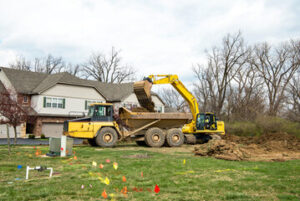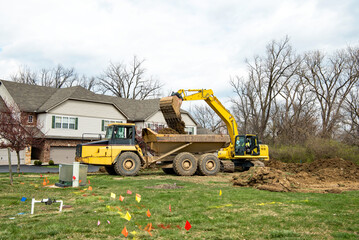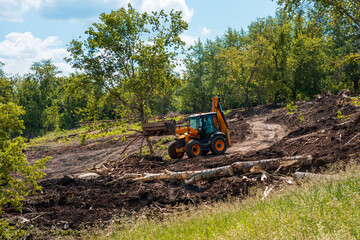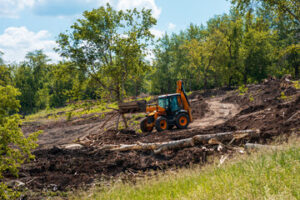Choosing the right Excavating Contractor can save time, prevent future issues, and keep commercial construction projects on schedule. By evaluating experience, licensing, equipment and past work you can select the contractor that best meets your needs.
Contractors who specialize in excavation perform a variety of tasks to prepare surfaces and areas for new installations. From digging foundation trenches to preparing sites for concrete pouring, these professionals take their jobs seriously and deliver great work results.
When a new building is being constructed, excavation contractors dig the foundation trenches. This is a critical step in the construction process and can lead to structural instability or other problems down the road if it’s not done correctly. Professional excavators use the proper equipment and knowledge to ensure that these trenches are deep enough and that they’re lined with concrete and other materials that will prevent water and moisture from seeping in.
These experts are also responsible for installing a variety of utilities. This includes sewage, electricity, and water lines. They dig narrow excavations and ensure that these new lines are placed accurately, without causing any damage to existing services. These projects involve digging across property lines, so a knowledgeable and experienced excavation contractor will be sure to notify local utility providers before beginning work.
Professional excavators can help with other site prep tasks as well. For example, they may be called on to remove trees or boulders that are in the way of a construction project. They also handle drainage issues by rerouting stormwater and preventing erosion, which is crucial for protecting the longevity of the completed structure.
Because they’re often hired on as subcontractors, excavation contractors should focus on marketing themselves in a way that separates them from the competition. They should be able to showcase their qualifications and experience, and they should be able to explain how their services will benefit clients. They should also discuss their insurance coverage, which should cover damages to the client’s property caused by an accident involving an excavator.
Finally, excavation contractors should be able to provide proof that they’re licensed and insured, which is required for many jobs. They should also be able to provide references from previous clients and show that they’ve worked on projects with similar specifications. This will give potential clients confidence that the excavation contractor will be able to complete the job efficiently and accurately. In addition, they should be able to provide details about the cost of their services, including any associated fees and taxes. This will ensure that clients aren’t surprised by any unexpected costs down the road.
Clearing
The site of a construction project will need to be cleared and prepared before excavation begins. Excavating contractors can assist with clearing land by removing any debris or obstacles from the excavation site using heavy machinery like bulldozers and backhoes. This includes removing trees, roots and other debris that could interfere with the process of digging foundations or building structures on the site.
After clearing the area, excavating contractors may need to prepare the ground by leveling it. This is done by adjusting the elevations in the soil to match those outlined in the construction plans. This will help to ensure that the final construction will be stable and secure.
Rough grading will also be necessary to get the ground ready for a home foundation. This will involve ensuring that the slope of the soil is correct to allow for drainage and other essential factors. Erosion control measures will also be put in place to prevent the dirt from washing away after a rainstorm.
Paving is another common job that excavating contractors do on residential and commercial properties. This helps to improve the appearance of the property and can increase the value and usefulness of the space. Proper attention to excavation during the paving process is vital to make sure that there are no problems with drainage and that the new pavement will last for a long time. This is especially important as weather and other elements can cause damage to asphalt quickly. Having a qualified excavating contractor on hand to handle the necessary excavation and paving can save you a lot of headache down the road.
Pouring Concrete
When it comes to construction, pouring concrete is a key process that contributes to the strength and durability of a structure. It requires precision and attention to detail to get the best results. Several factors directly influence the outcome of a concrete pour, including the type of concrete used and the method of placing it.
Before the concrete is poured, it’s important to prepare the site by clearing any material that could interfere with the procedure. This includes removing any debris, rocks or old concrete. It’s also important to ensure the forms are in place and secured. Once the area is ready, it’s time to start mixing and pouring.
There are two main methods for pouring concrete: dry and wet. Dry pouring, or gunite, involves mixing the concrete ingredients on-site and pneumatically projecting them onto a surface. The wet process, on the other hand, mixes all the concrete components (cement, sand, and aggregate) at a central plant or batching facility. Both processes have their benefits, but wet concrete is easier to work with because it’s more pliable.
If you’re using a gunite system, it’s important to have the right mix on hand and to follow the manufacturer’s instructions for mixing. Also, be sure to use a concrete broom to create ridges in the concrete’s surface. This helps increase traction and is essential for areas that will be exposed to the elements.
It’s also important to know what kind of slump you’re working with, which can be determined by conducting a slump test on the concrete when it arrives at the job site. A low slump means the concrete has a lot of water and is easy to work with, while a high slump means it’s stiffer and less pliable.
The next step is to spread the concrete evenly across the formwork. This can be done by using a shovel or a concrete come-along rake. It’s important to avoid concentrating the concrete in one area, as this can lead to air pockets that weaken the strength of the concrete. After spreading the concrete, it’s a good idea to vibrate it to help dislodge any trapped air bubbles and promote even distribution.
Paving
A paving job involves covering an excavated area with a pliable material, like asphalt. This type of paving is often used on roads and highways because it can withstand the weight of vehicles. Before a paving project can begin, the ground must be cleared of any debris and prepared by adding a binder layer—a mixture of large aggregate stones and oil that creates a strong foundation for the top layer of asphalt to adhere to.



